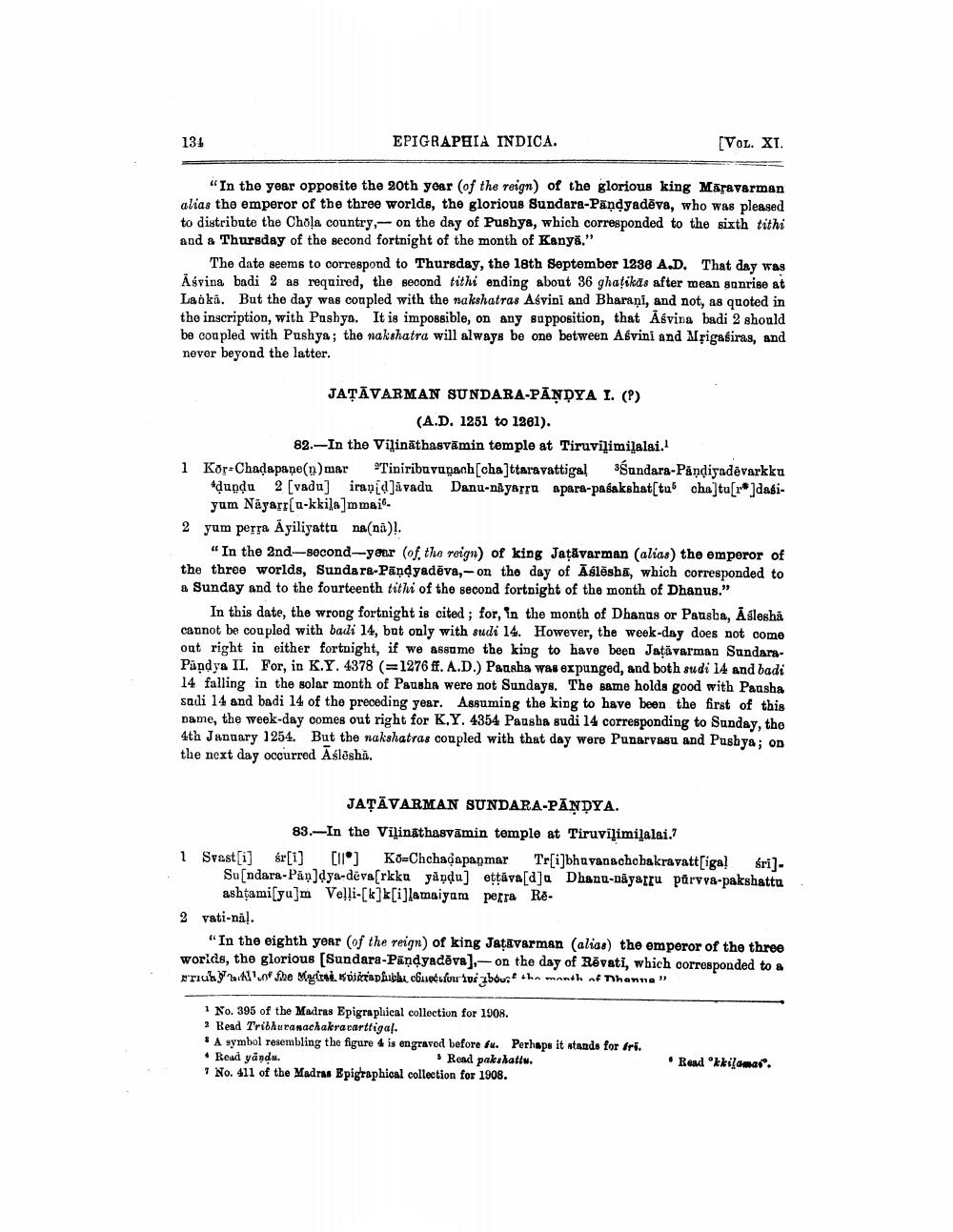________________
131
EPIGRAPHIA INDICA.
[VOL. XI.
"In the year opposite the 20th yoar (of the reign) of the glorious king Maraverman alias the emperor of the three worlds, the glorious Sundara-Pāņdyadēva, who was pleased to distribute the Chola country, on the day of Pushya, which corresponded to the sixth tithi and a Thursday of the second fortnight of the month of Kanya."
The date seems to correspond to Thursday, the 18th September 1238 A.D. That day was Āśrina badi 2 as required, the second tithi ending about 36 ghatikas after mean sonrise at Lanka. But the day was coupled with the nakshatras Asvini and Bharani, and not, as quoted in the inscription, with Pushya. It is impossible, on any supposition, that Asvina badi 2 should be coupled with Pushya; the nakshatra will always be one between Abvini and Mrigasiras, and never beyond the latter.
JATAVARMAN SUNDARA-PĀNDYA I. (R)
(A.D. 1251 to 1261). 82.- In the Visināthasvāmin temple at Tiruviļimiļalai.! 1 Kor Chadapane(n)mar Tiniribavugach[cha]ttaravattigal Sundara-Pandiyadēvarkku
duodu 2 (vadu] iranid]āvadu Danu-năyarra apara-pasakshat(ta cha]tur*]dasi
yum Nayarr[u-kkila]mmail2 yum perra Āyiliyatta na(na)!.
"In the 2nd-second-year of the reign) of king Jaţăvarman (alias) the emperor of the three worlds, Sundara-Pandyadēva,- on the day of Aslēsha, which corresponded to a Sunday and to the fourteenth tithi of the second fortnight of the month of Dhanus."
In this date, the wrong fortnight is cited; for, in the month of Dhanus or Pausla, Aslesha cannot be coupled with badi 14, but only with sudi 14. However, the week-day does not come out right in either fortnight, if we assume the king to have been Jaţăvarman SundaraPandya II. For, in K.Y. 4378 (=1276 ff. A.D.) Paasha was expunged, and both sudi 14 and badi 14 falling in the solar month of Pausha were not Sundays. The same holds good with Paasha sadi 14 and badi 14 of the preceding year. Assuming the king to have been the first of this name, the week-day comes out right for K.Y. 4354 Pausha sudi 14 corresponding to Sunday, the 4th January 1254. But the nakshatras coupled with that day were Punarvasu and Pushya; OD the next day occurred Aslesha.
.
JAȚĀVARMAN SUNDARA-PĀNDYA.
83.-In the Viļinathasvāmin temple at Tiruviļimiļalai.7 1 Svast[i] $r[i] [11] KO=Chchaqapanmar Tr[i]bhuvanachchakravatt[iga! sri].
Sundara-Pāŋ]dya-deva[rkku yàodu] ettáva[aja Dhanu-dāyatru pärvva-pakshattu
ashtami (yu]m Velli-[k]k[i]lamaiyam perra Re2 vati-na!.
"In the eighth year of the reign) of king Jaţavarman (alias) the emperor of the three worlds, the glorious (Sundara-Pandyadēva),- on the day of Rēvati, which corresponded to a priuk All the Myinti svitaphiuchi coletuluius about the month of Thenne"
1 No. 395 of the Madras Epigraphical collection for 1908. 2 Read Tribhuranachakrararttigal. ! A symbol resembling the figure 4 is engraved before fu. Perhaps it stands for fri. * Readi yandu.
Read pakshattu. * No. 411 of the Madras Epigraphical collection for 1908.
. Read Okkilomar.




